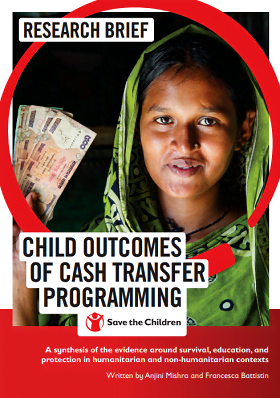Child Outcomes of Cash Transfer Programming: Research Brief
Humanitarian emergencies are increasing in both frequency and duration. It is evident that children bear the brunt of these situations and that these experiences have long-lasting effects on their development and future. The figures for the number of children affected by humanitarian emergencies are worrying: in 2014, children comprised half or more of those affected by natural disasters (approximately 50 million children) and 51% of refugees were children. Additionally, 34 million children and adolescents are out of school in conflict-affected countries; nine out of ten countries with the highest rates of child marriage are fragile states; 60% of preventable maternal deaths and 53% of under-five deaths take place in settings of conflict, displacement
and natural disasters; and in 2013, 65% of all children living in conflict zones (i.e. 112.1 million children) were chronically undernourished.
This systematic review attempts to fill an evidence gap by reviewing a comprehensive list of indicators around outcomes for children in health, food security, nutrition, protection, and education. These indicators include both those that directly affect children, such as the child’s health, and those that indirectly concern children, such as maternal health status. The study includes evidence from both humanitarian and non-humanitarian contexts, with no specific geographical or socio-political focus. We considered evidence generated between 2012 and 2016, as we were interested in the latest findings available on this matter, and the available resources did not allow for a wider search.
This Research Brief offers a condensed account of the findings and conclusions of a longer full report. Readers interested in examining specific aspects in greater depth, are recommended to refer to the full report on “child outcomes of cash transfer programming: A synthesis of the evidence on survival, education and protection in humanitarian and non-humanitarian contexts”. This full report contains a more comprehensive version of the research methods as well as of the findings, bibliographic references, and wider implications on the use of cash transfer programming for children’s wellbeing and further research. It also contains the full version of the study protocol.
Also available:



